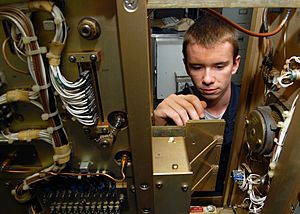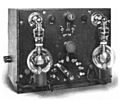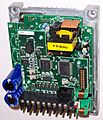Electronics facts for kids

Electronics is a super cool field that studies how to control tiny bits of electricity to make amazing things happen! It's all about using special electrical parts and circuits to do useful jobs. Think about your phone, computer, or even a simple light switch – they all use electronics.
Electronic devices are built with many different electronic components. Some common ones are resistors, capacitors, coils of wire called inductors, and integrated circuits. These parts are connected together, often on special boards called circuit boards, with lots of tiny wires.
Contents
From Big Tubes to Tiny Chips
For a long time, older electronic devices used large glass or metal tubes called vacuum tubes to control electricity. These tubes could change a small electrical signal into a bigger one, making them useful for things like amplifiers and switches.
But by the late 1960s and early 1970s, something much smaller and more efficient came along: the transistor. Transistors are tiny electronic switches made from semiconductor materials. They quickly started replacing vacuum tubes because they were much smaller and used a lot less energy.
Around the same time, integrated circuits (often called ICs or "chips") became popular. Imagine putting thousands or even millions of tiny transistors onto a super thin piece of silicon – that's an integrated circuit! ICs made it possible to build electronic products that were much smaller, more powerful, and cheaper to make.
Who Works with Electronics?
People who are really interested in how these electronic parts work, and who like to invent or improve them, often study physics. They explore the science behind electricity and materials.
People who design, build, and fix electronic parts and circuits are called electrical engineers. They work in exciting fields like electrical, electronics, and computer engineering, creating everything from power grids to the latest smartphones.
Types of Electronic Systems
Most electronic systems fit into two main groups:
- Information Systems: These systems handle and share information. Think of them as communications systems, like your phone sending a text message or a radio broadcasting music.
- Control Systems: These systems manage and distribute energy. They are used to control how machines work, like the electronics that make a robot move or a factory machine operate.
How Electronic Systems Work
You can think of almost any electronic system as having three main parts:
- Inputs: These are like the "senses" of an electronic device. Electrical or mechanical sensors take information from the real world (like temperature, pressure, or light) and turn it into electrical signals (currents and voltages).
- Signal Processing: This is the "brain" of the system. It's made of electronic parts connected together that take the input signals and change them. They might make the signals stronger, filter out noise, or turn them into a different kind of information.
- Outputs: These are what the system "does" with the processed information. Actuators or other devices turn the electrical signals back into something we can understand or use, like a picture on a screen, sound from a speaker, or movement from a motor.
Let's look at a television as an example:
- Input: The TV gets its input from a broadcast signal through an antenna or from a cable. This signal carries all the information for the picture and sound.
- Signal Processing: Inside the TV, special circuits take the signal and separate out the brightness, colour, and sound information. They then prepare this information to be shown on the screen and played through the speakers.
- Outputs: The TV's display (like a liquid crystal display screen) takes the processed brightness and color information and turns it into the image you see. The speaker takes the processed sound information and turns it into sounds you can hear.
When engineers know what goes into a circuit (the input) and how the circuit is built (the signal processing), and they figure out what comes out (the output), that's called analysis. If they know what they want to go in and what they want to come out, and they design the circuit to make it happen, that's called synthesis.
Analog Circuits
Analog circuits work with signals that can change smoothly over a wide range, like the volume knob on a radio. They are often used to measure or control the strength (amplitude) of signals. In the early days, all electronics used analog circuits. Even though digital circuits are super common now, analog circuits are still very important for many things, like measuring real-world conditions.
Pulse Circuits
Pulse circuits are designed for signals that come in quick, strong bursts of energy. A great example is radar equipment used in aircraft and on the ground. Radar uses pulse circuits to create and send out powerful bursts of radio energy from a transmitter. These bursts are sent in a specific direction using special antennas that look like beams or dishes.
When these radar bursts hit hard or metallic objects (like buildings, mountains, airplanes, or even satellites in space), they bounce back, or "reflect." Radar receivers then detect this reflected energy. These receivers use both pulse and digital circuits to figure out where the objects are and how far away they are.
By controlling how often the radar sends out pulses (called "pulse timing") and measuring how long it takes for the reflected energy to come back, radar can tell you both the location and distance of an object. Digital circuits in the radar receiver calculate the distance by multiplying the speed of light by the time it took for the pulse to travel to the object and back.
The time between pulses (often called "pulse rate time," or PRT) affects how far away an object can be detected. This distance is called the "range" of the radar. Long PRTs are used to detect objects very far away, like the moon. Fast PRTs are used for closer objects, like ships at sea or cars on a highway, and can even help measure their speed.
Digital Circuits
Digital circuits work with signals that are either "on" or "off," like a light switch. When they are "on," they have a steady strength, and when they are "off," they have no strength. Digital circuits are great at counting how many times something switches on and off.
Things like Computers and electronic clocks are mostly made up of digital circuits. They use these on/off signals to process information and perform calculations.
Some basic building blocks of digital circuits include:
- Logic gates: These are like tiny decision-makers.
- Flip-flops: These can store a single bit of information (a 0 or a 1).
- Counters: These count pulses.
More complex digital devices are built from these basic parts, such as:
- Microprocessors: The "brain" of computers.
- Microcontrollers: Small computers used to control other devices.
- Digital signal processors: Special chips for processing digital signals, like sound or video.
Images for kids
-
Modern surface-mount electronic components on a printed circuit board, with a large integrated circuit at the top.
-
One of the earliest Audion radio receivers, built in 1914.
See also
 In Spanish: Electrónica para niños
In Spanish: Electrónica para niños





